Family : Myrtaceae

Text © Prof. Pietro Pavone

English translation by Mario Beltramini
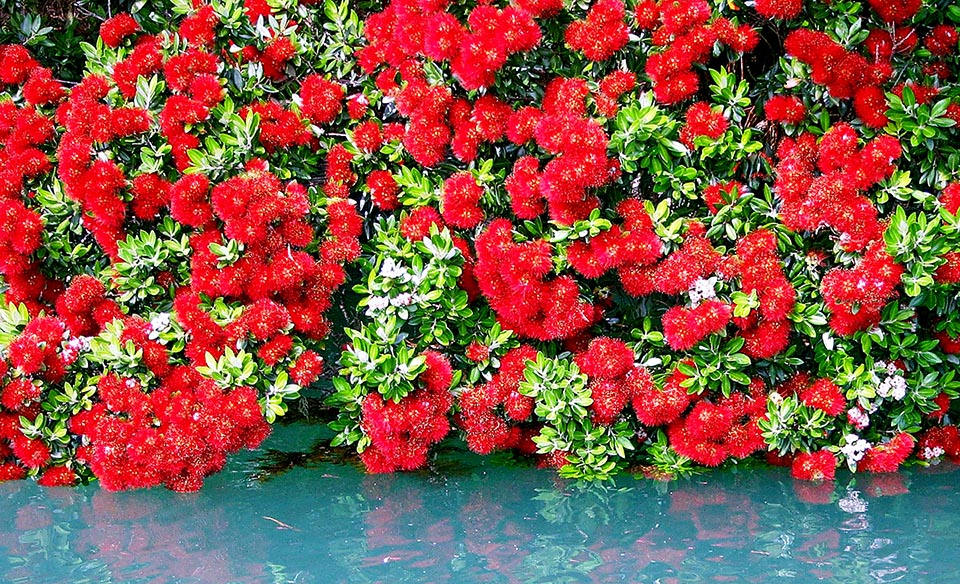
Locally known as Christmas Tree, Metrosideros excelsa is in full blooming in New Zealand during this holiday © Tony Foster
Metrosideros excelsa Sol. ex Gaertn. is a species of the family Myrtaceae native to the coastal regions of the North Island of New Zealand, introduced, byt the natives, in the South Island, up to Dunedin.
Metrosideros excelsa in its natural environment is found with solitary plants as well as plants integrated with the coastal forest and hinterland.
In the extreme north of the island, the species is associated with the forest of Kauri (Agathis australis), but, in some sites, forms a pure forest.
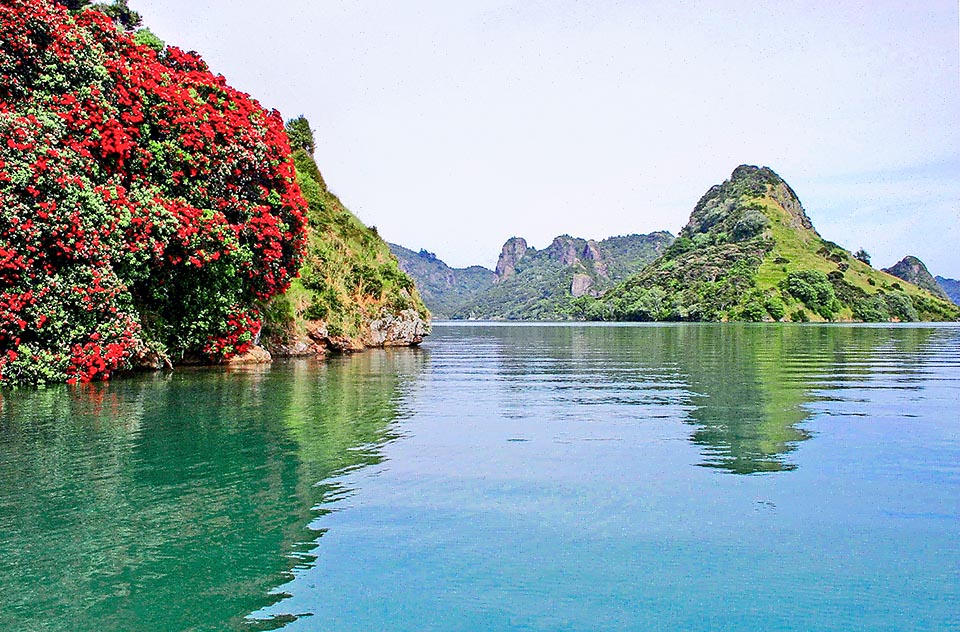
Here growing on Wairaupo or Milford island shores, splendid scenery in north New Zealand © Tony Foster
Due to its ability to take root on the volcanic substrata, it has been able to colonize the volcanic island
Whakaari/White Island (Bay of Plenty Region) even if continuously disturbed by the lava flows and by the toxic rivers.
It is found also on the small uninhabited island of Moutohora/Whale Island in the form of small shrubs growing close to fumaroles.
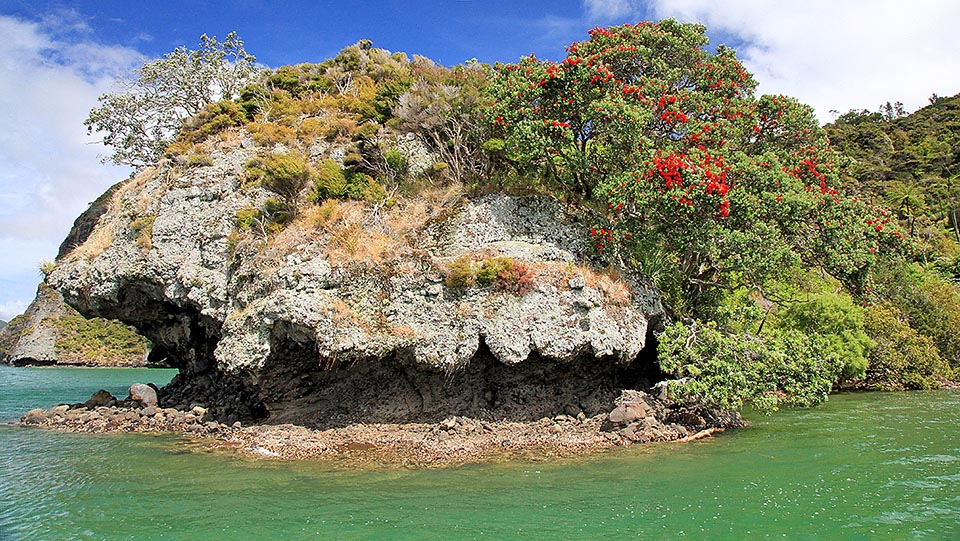
Metrosideros excelsa does not fear coastal saltiness, in fact the Maori call it “Pōhutukawa” that means “wet from spray © Tony Foster
In the hinterland of the North Island, are present populations of Metrosideros excelsa on the central volcanic plateau, on the shores of the lakes of Rotorua, Ōkataina and Taupo and along the Tarawera River that flows along the north side of the homonymous volcano. In the past it was also present on the cliffs of the lake Waikaremoana (Te Urewera).
It is probable that the internal populations come from Maori plantations and that later on have expanded spontaneously, although not all scholars do agree.
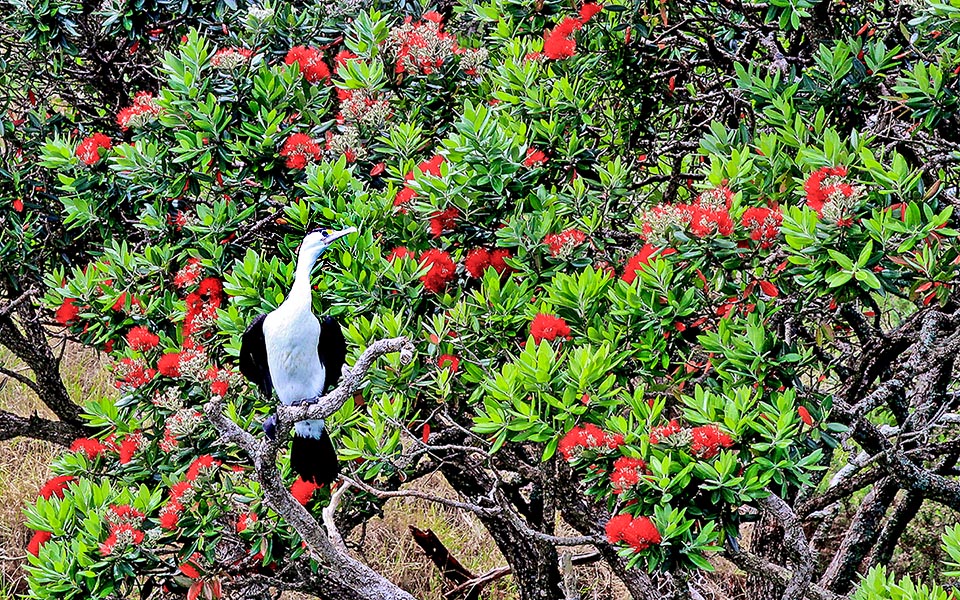
It blooms also close to mangroves formations where the Australian pied cormorant (Phalacrocorax varius) and egrets often nidify © Tony Foster
As a matter of fact, it is probable that the inner forests are fragments of the colonization of the lava surfaces formed by the Ōkataina in the late Pleistocene and early Holocene.In Tasmania they have found the first fossils attributable to the genus Metrosideros and this presence indicates that the species of this genus were in those locations about 30 million years ago.
In Australia there are no Metrosideros, most probably because in this continent there were no favourable habitats and the possible present species became extinct.
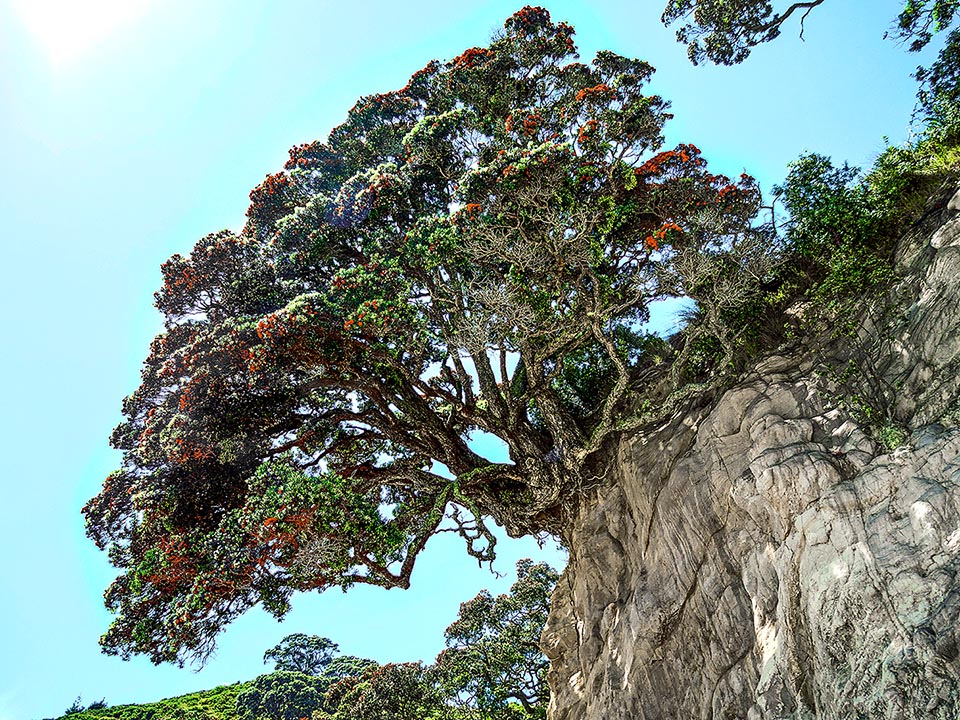
It’s a plant living even overhanging a rock. Here the flowers contrast with the lower white tomentose pagina of the growing leaves © Michael Schwab
Conversely, it is thought that New Zealand could be better suited for their development, at least for the species of the subgenus Metrosideros. Moreover, based on the long fossil documentation found on the island (pollen dating back to the late Paleocene/early Eocene and fossil wood of the Early Miocene) and thanks to studies of phylogenetics, it is possible to hypothesize that species belonging to this subgenus from this territory have diffused to other islands of Oceania up to the remotePolynesia.
The dispersing agent certainly must have been the wind and the long distances have been overcome due to the capacity of the seeds to maintain their vitality at the low temperatures that occurred during the Pleistocene glaciations. The chromosome number is 2n=22.
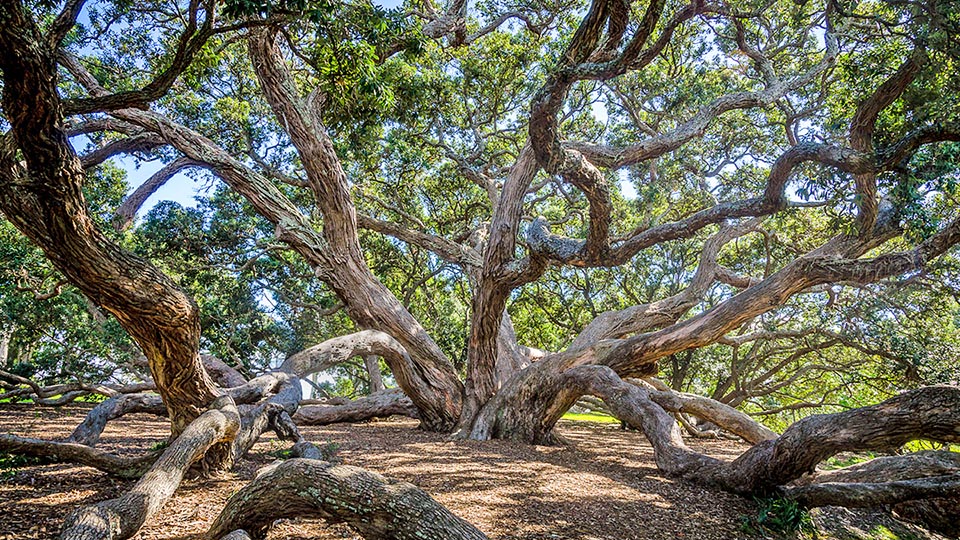
If the soil is fertile grows dramatically over time, like here. The branches touching the soil take root and rise vigourously creating also a 10-50 m expanded crown © Kathrin & Stefan Marks
The name of the genus Metrosideros comes from the old Greek μήτρα (mḗtra) “womb” and σίδηρος (sideron” “iron” with reference to the hardness of the wood. The term excelsa means high, lofty or exceptional, probably due to the size of the plant and its massive flowering.
The common name is New Zealand Christmas tree, because it blooms during the Christmas period in its origin countries. In the Maori language it is called Pōhutukawa that means “wet from the spray”, to indicate the coastal environment where this plant has well adapted.
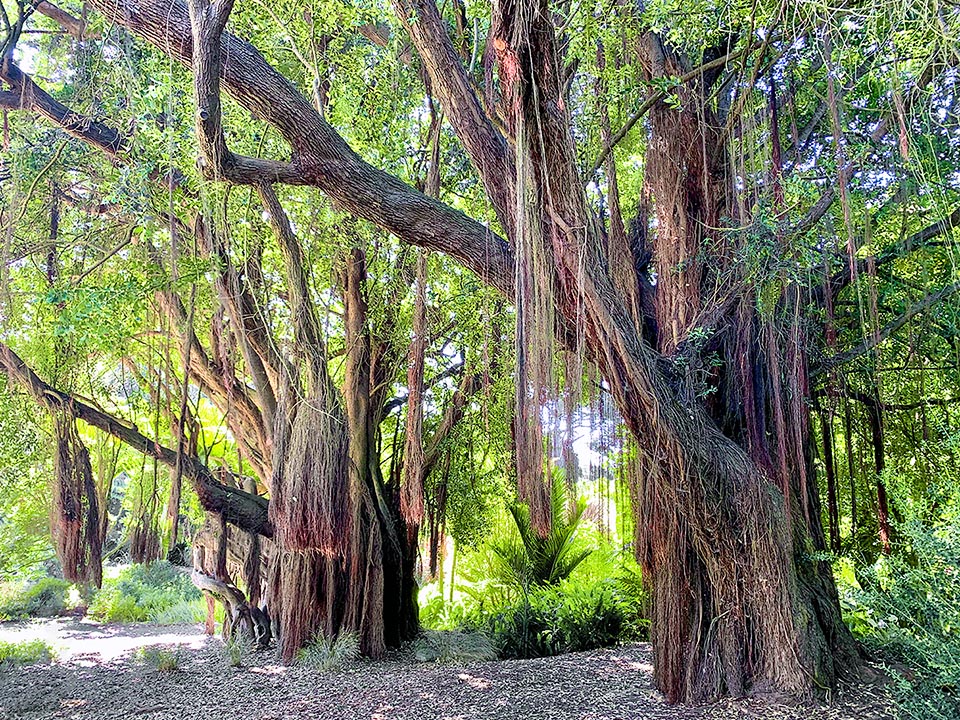
The survival of this evergreen, up to 20 m tall, is entrusted also to showy aerial roots that go down from the branches looking for water and for food © Kyle Wicomb
Joseph Banks (1743-1820) and Daniel Carl Solander (1733-1782) collected specimens of this plant during the first voyage (1769) of James Cook (1728-1779) in New Zealand, but it was Joseph Gaertner (1732-1791) who validly published, in in De Fructibus et Seminibus Plantarum (Fruct. Sem. Pl. i. 172. t. 34. f. 8, 1788), in De Fructibus et Seminibus Plantarum (Fruct. Sem. Pl. i. 172. t. 34. f. 8, 1788), the name of the species together with a short description.
It is an evergreen tree that may reach the height of 2 m, with a crown extending 10-50 m. Typically, it is characterized by several trunks at the base of up to 2 m of diameter, with expanded and arcuate branches, at times resting on the ground and/or with adventitious roots.
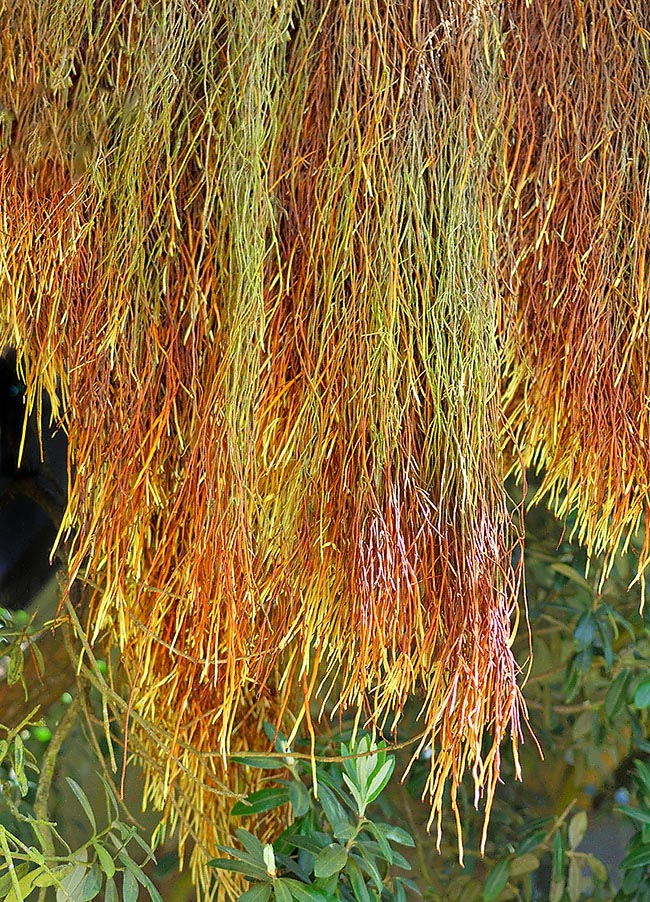
To protect from the dangerous ultraviolet rays these roots present red-orange pigments © Eric Hunt
The branches are numerous and when young are covered by a deciduous down of white-greyish colour.
The bark is robust, rather corky, persistent and difficult to detach, often strongly grooved, of colour varying from grey to grey-brown.
The leaves are coriaceous, 25-120 x 25-60 mm, elliptical, oblong, at times lanceolate with apex sharp or obtuse, of olive green colour, with the lower pagina covered by white tomentum and the upper initially tomentose but glabrous when mature.
The inflorescences are compound because on the main axis are inserted other inflorescences bearing three flowers with robust and tomentous peduncles. One single inflorescence is formed on average of 14-15 flowers.
The flowers are hermaphroditic with conical flower involucre (hypanthium) to which are attached the perianth and the stamens and with ovary in the center. The stamens are numerous (about 27) with (20) 30-37 (40) mm long filaments, of scarlet red colour, but in some cultivars the colour may be orange, pink, yellow or white.
In fact, in the isolated populations, the genetic drift has led to variations of the colour of the flowers. Many plants growing around the lake Rotorua produce pink-tinged flowers. The yellow flowered cultivar “Aurea” has got origin from plants found, for the first time, in 1940, on the island of Mōtītī in the Bay of Plenty.
In the origin countries the blooming takes place in the months of November-December, the plants cultivated in the boreal hemisphere flower from May to August.
Based on the position of the individual trees, in shade or light, the flowering times may vary.
The calyx is formed by five green sepals, 5-toothed, the corolla by 5 red petals, oblong and persistent. Both sepals and petals present small hairs on the edges. The anthesis lasts about fifteen days and the single flowers are fertile for about 7 days after the following succession. The female phase begins with the maturation of the pistil and lasts about one day and a half, follows the hermaphroditic phase that, averagely, lasts four days, sometimes more, during which occurs the release of pollen from the anthers. Then comes a further female phase where the stigmas remain receptive for a minimum of none days, but the pollination is rather rare because there are pollinators as they do not find any more nectar, being this already exhausted.
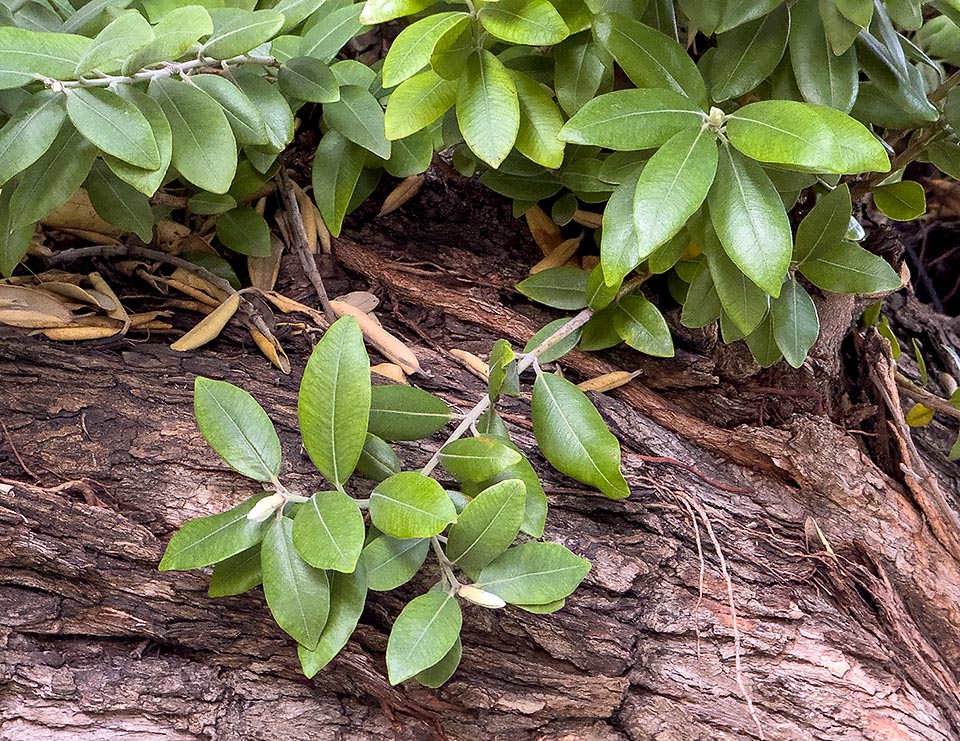
The leaves are coriaceous, olive green ob the upper pagina. Bark is robust and corky © Giuseppe Mazza
Under these conditions is possible the pollination with the pollen of the same flower (autogamous self-pollination) as well as the pollination with pollen of another flower of the same individual (geitonogamy).
All ovules inside the ovary are potentially fertile but their number for forming fertile seeds is low (about 10,2%), irrespective of the availability of pollen. However, despite the low vitality of the seeds, the overall production per tree is sufficiently high.
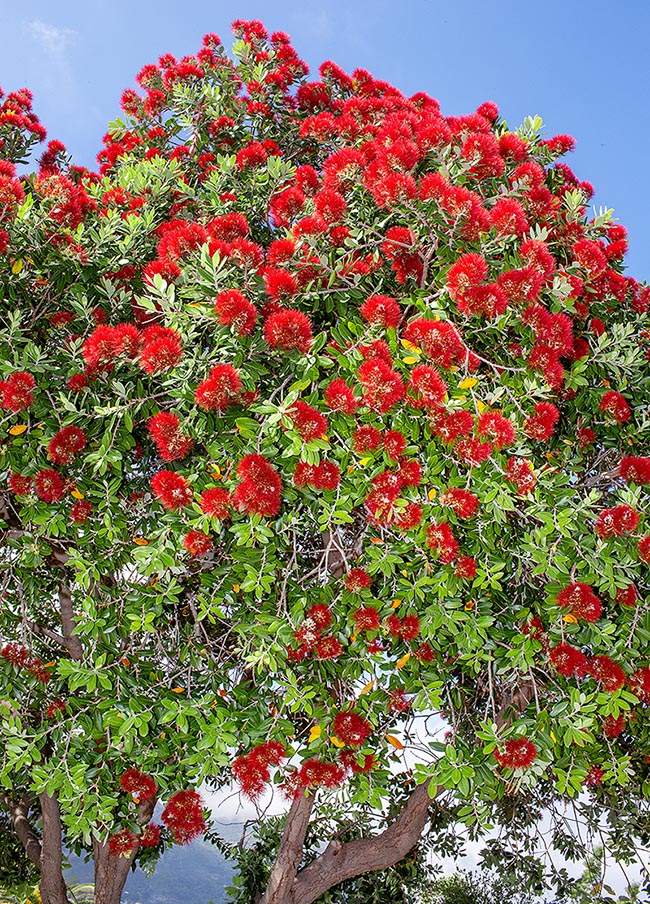
In plants cultivated in the north hemisphere blooming occurs between May and August © Giuseppe Mazza
The flowers produce abundant quantities of nectar in order to attract the pollinators.
The red flower attracts the birds that are more suitable to induce the formation of the fertile seeds as they promote the genetic variability due to their capacity of moving among the various plants. With the introduction in the New Zealand environments of the honey bees it has been noted that they are more effective than the indigenous bees, because of their larger body size that favour the contact with the stigma.
Have been reported also nocturnal visits of geckoes typical of New Zealand and New Zealand lesser short-tailed bats (Mystacina tuberculata Gray, 1843).
Also the Black rat or Common rat (Rattus rattus Linnaeus, 1758), invasive species standing among the most harmful in the world, and the Silvereye or White-eye [Zosterops lateralis (Latham, 1801)] contribute partially to the process of pollination especially for the hinterland specimens.
In their places of origin the fruits ripen in the months of (January)-March-April-(May).
About 60% of the seeds produced are self-pollinated and are dispersed by the wind. The seeds have no endosperm (vegetable tissue with reserves useful for the growth of the embryo) and their coating is thin, this renders them vulnerable to desiccation. Therefore, the seeds may persist in the soil only for a short time and must find suitable conditions of humidity for an immediate germination.
As well as providing a source of nectar, Metrosideros excelsa provides hospitality to wildlife.
The Great pied cormorant (Phalacrocorax varius J. F. Gmelin, 1789) and the Egrets (Egretta spp.) often perch and nidify on these plants. The caterpillars that bore into the trunks create nesting sites for birds like the passeriform Saddleback (Philesturnus carunculatus (Gmelin, 1789).
In the flowers have been identified seven distinct anthocyanins, responsible for their colour. These are delphinidin-3-glucoside, malvidin-3-glucoside, cyanidin-3-glucoside, petunidin-3-glucoside, peonidin-3-glucosid, cyanidin-3,5-diglucoside and malvidin 3,5-diglucoside.
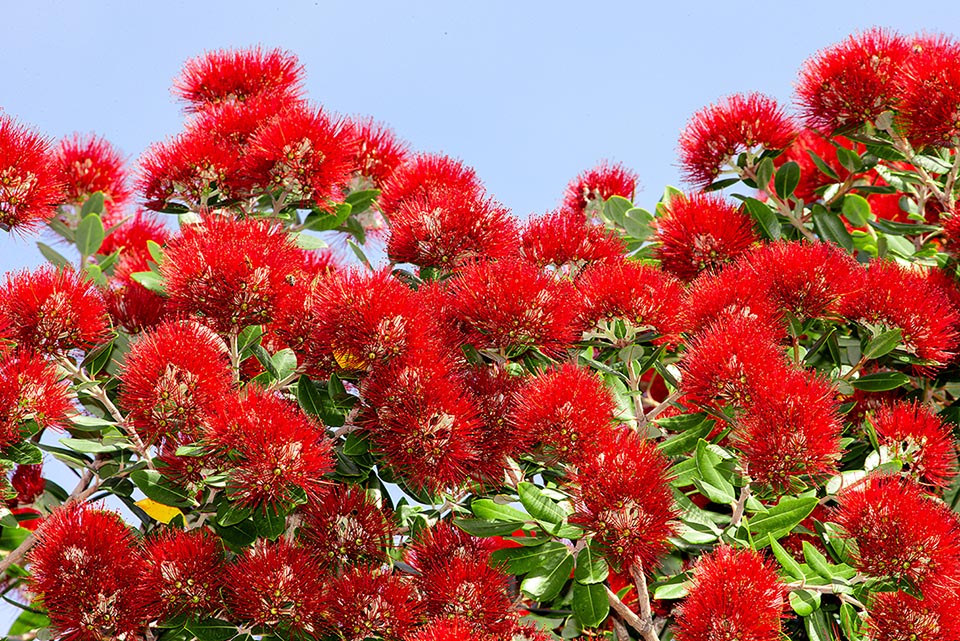
The compound inflorescences, formed by more inflorescences inserted on the main axis with strong and tomentose peduncles, averagely bear 14-15 flowers © G. Mazza
Also the adventitious roots present pigments based on cyanidin and delphinidin that are found only in the outermost tissues. It is likely that the light may stimulate the production of these pigments for protecting them against the strong ultraviolet summer radiation (UVB).
Metrosideros excelsa and Metrosideros umbellata Cav. (rātā) occupy a prominent place in the Maori mythology. There is a legend that the young Maori warrior attempted to find help in heaven to avenge his father’s death, but fell to the ground and the crimson flower represent his blood.
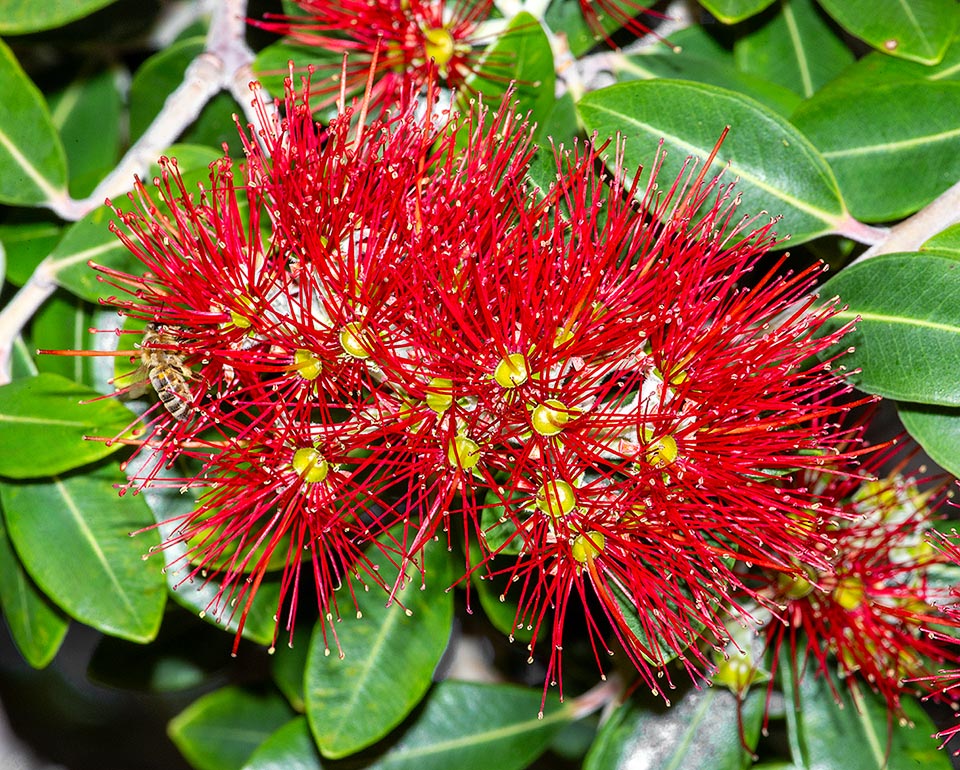
Flowers are hermaphrodite with conical flower involucre called hypanthium. Among pollinators, introduced in New Zealand for the excellent honey, often stand bees © Giuseppe Mazza
In the Maori mythology the most famous plant is a small 800 years old tree, clung to the rock wall close to Cape Reinga, north-west of Aupouri Peninsula, that is deemed to guard the entrance to the sacred grotto through which the disembodied spirits migrates towards the afterlife.
Metrosideros excelsa has undergone a serious decline, before due to the fires caused by the Maori, then for the deforestation of the territory of XIX century done by the European immigrants, following the expansion of pastoralism.
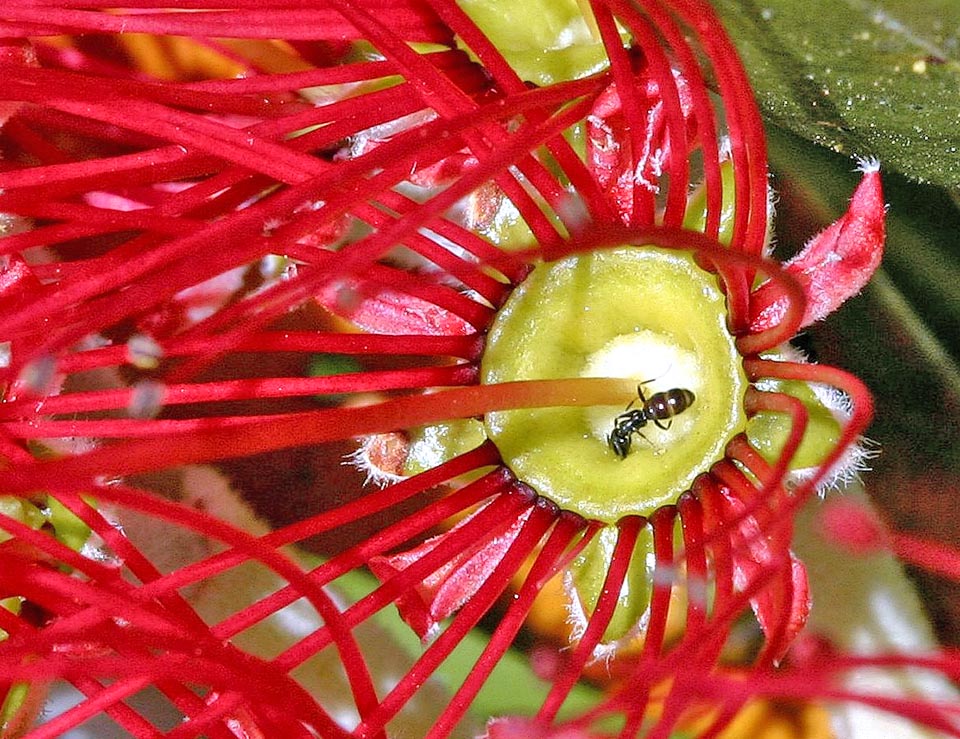
Also the ants attracted by the sugary substances of hypanthium, with ovary at center and around the stamens, concur to the pollination © Tony Foster
The pressure of the herbivores introduced continues to pose a serious threat for the populations that now are reduced to approximately the 10% of their original extension.
Moreover, due to the propension to the self-fertilization that leads to an increase of the homozygosis, to a decrease of the genetica variability and to a deterioration of vigour (inbreeding depression) it is possible that with the time we may have the extinction of this species.
To make the situation worse, in 1840, has been introduced in New Zealand the Common brushtail possum [Trichosurus vulpecula (Kerr, 1792)], an opossum representing a real disaster for its multiple impacts.
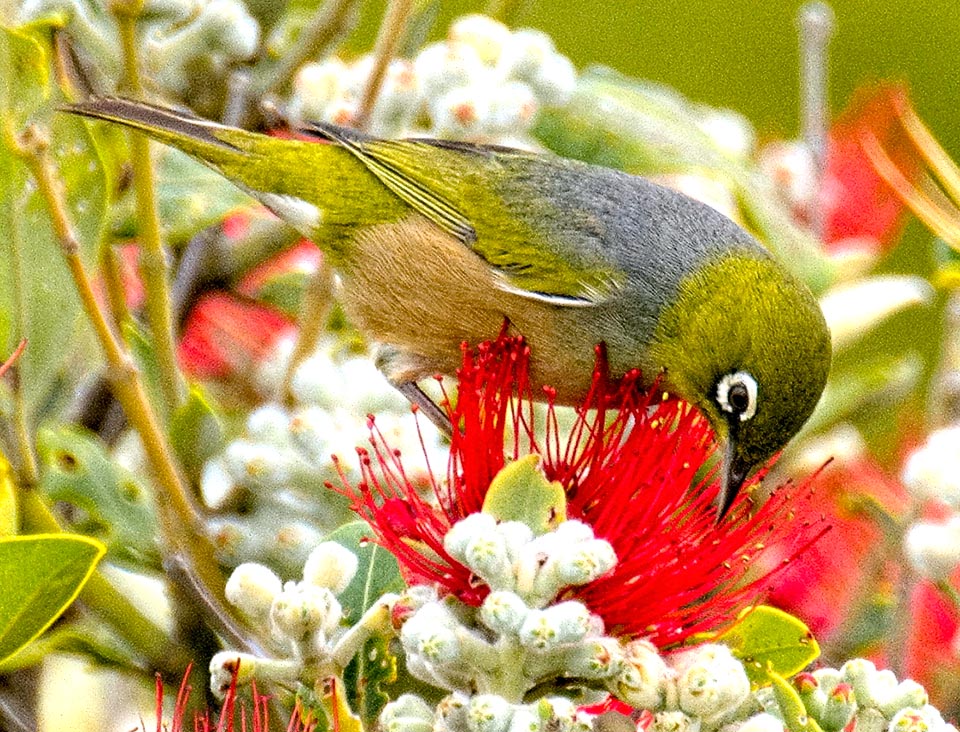
And among pollinators stand also birds like this Silvereye (Zosterops lateralis) and parakeets like Trichoglossus haematodus © Rebecca Bowater
In 1989 the Forest Research Institute did an inquiry about the populations of Metrosideros excelsa in the western coast of the Northland and the result was that 90% of these had disappeared. Therefore, in New Zealand
Metrosideros excelsa is considered as vulnerable with a high risk of extinction in the medium term.
In order to contain this phenomenon the Northland regional Conservation Department has cerated a project for the repopulation of this species as well as of the similar Metrosideros umbellata.
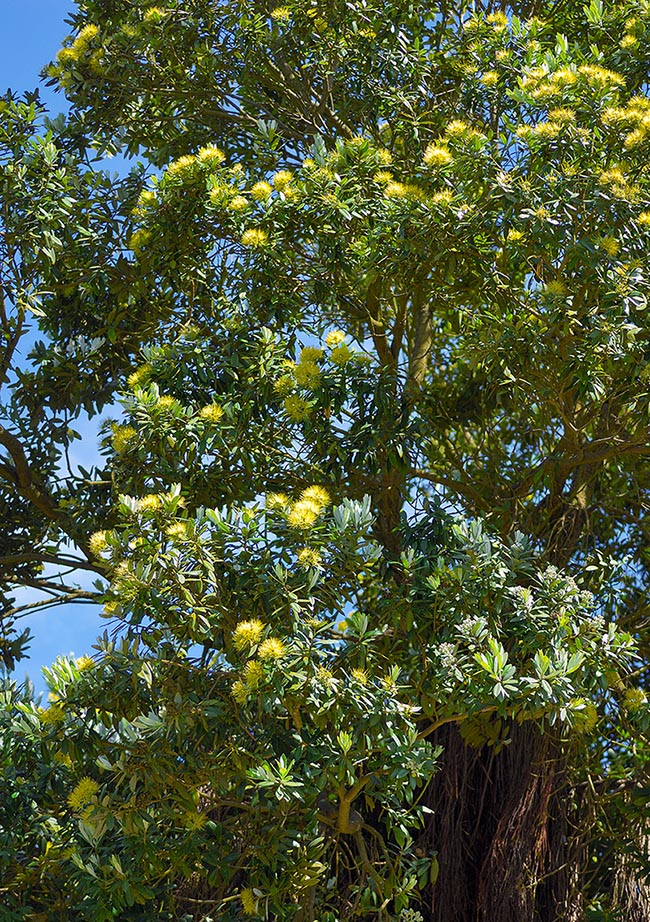
Besides red flowers, Metrosideros excelsa has also a no less attractive yellow variety © Eric Hunt
Therefore, in 1990, became active the Project Crimson Trust, a non-profit organization for promoting the repopulation and the protection of the arboreal species of Metrosideros threatened by the voracity of the opossum that besides being predator of birds and small mammals, feeds on leaves and hollows out tree trunks with the possible collapse of the crown.
The opossum is also vector of the bovine tuberculosis and consequently represents an important threat for the deer livestock industries and of the dairy industries of that country.
Initially born for the protection and the renewal of the two species of Metrosideros, in 2016, with the program Trees That Count, have been included all species of native trees.
Nevertheless, in spite of the efforts of the local population for containing the damages made by the opossums, another risk is about to strike the Metrosideros endemic to New Zealand. This is the Myrtle rust
[Austropuccinia psidii (G. Winter) Beenken (2017], fungal disease native to South America affecting the species of the family Myrtaceae.
In fact, in 2017 has been noted its presence on plants of the genus Lophomyrtus in the territory of Aotearoa (North Island). Experimental tests have highlighted that this rust could be dangerous also for the species of the endemic Metrosideros.
This presence represents, therefore, a serious problem due to its spreading capacity due to the production of very many spores that are dispersed by the wind and by other vectors, such as opossums, birds, bats and insects.
In the traditional herbal medicine Metrosideros excelsa has many uses. The Maori used the leaves of this plant locally for wounds and abrasions and extracts for treating the diarrhoea, dysentery, sore throat.
It has been proven that the bark contains ellagic acid, a natural antioxidant that has also anti-inflammatory properties.
The extract of the flowers is hydrating, rich in antioxidants and antiseptic. The flowers are appreciated also for the production of honey.
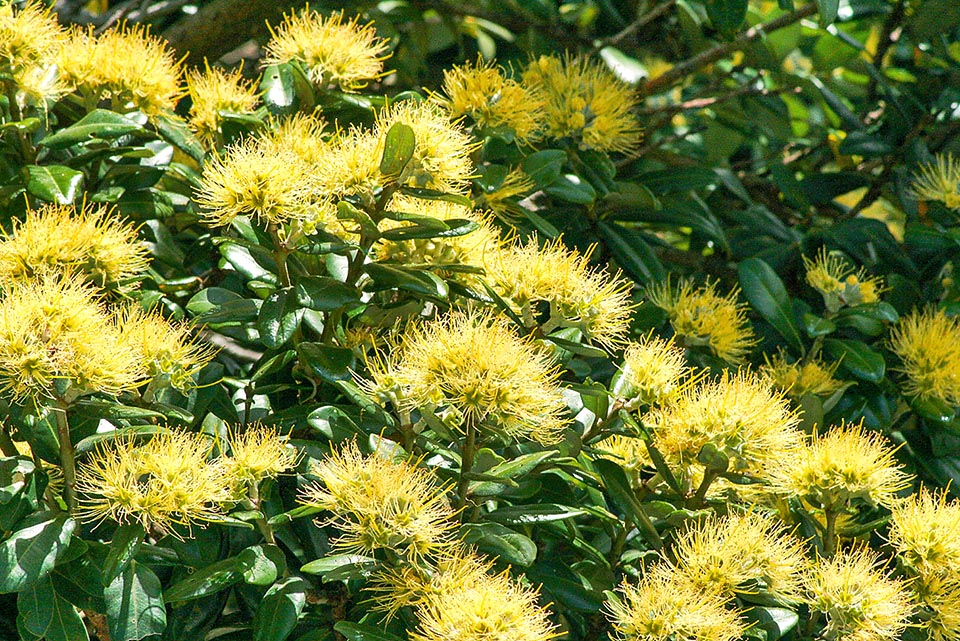
Here at its maximum splendour and are born cultivars and hybrids that have got the favours of lovers and collectors © Steve Attwood
The wood is thick, strong, and in the past was much utilized for shipbuilding also due to its natural sinuous shapes.
New Zealand is famous all over the world because of the exceptional results it has gotten in the alimentary as well as ornamental horticulture.
Were thus obtained cultivars and hybrids of Metrosideros that have met the favours of the enthusiasts and the collectors attracted by the flowers that contrast with the silver-grey colour of the leaves.
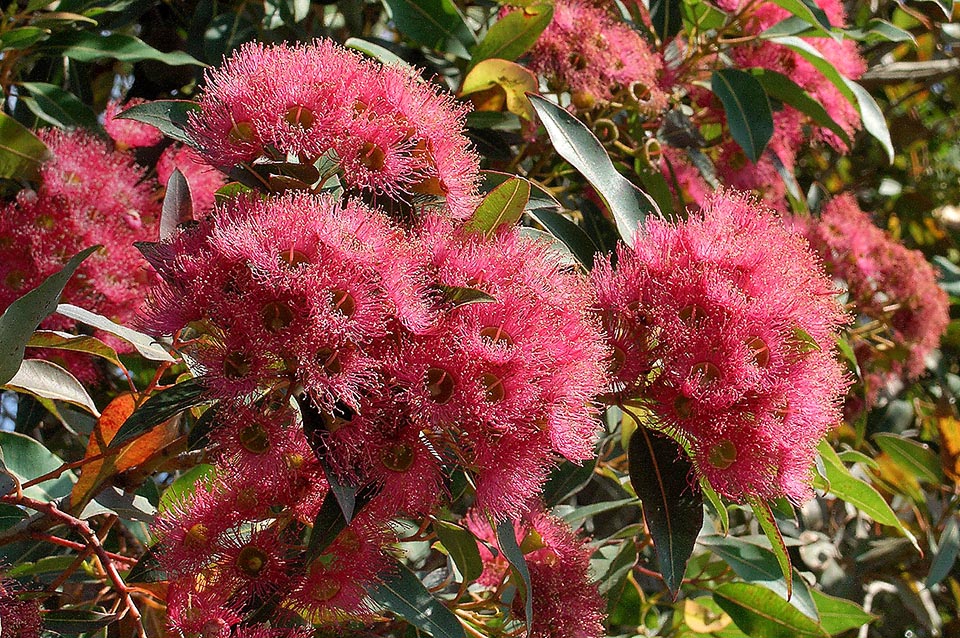
This is a pink triumph, often with very thick inflorescences and also an orange variety has been isolated © Peter Hunziker
In cultivation the reproduction is done by germination of the seeds that must be fresh, a few weeks at most, that is before they loose their vitality, especially if they are left to dry.
The reproduction by cutting is difficult, only the water sprouts of soft wood are able to take root.
Germination normally occurs after four to eight weeks.
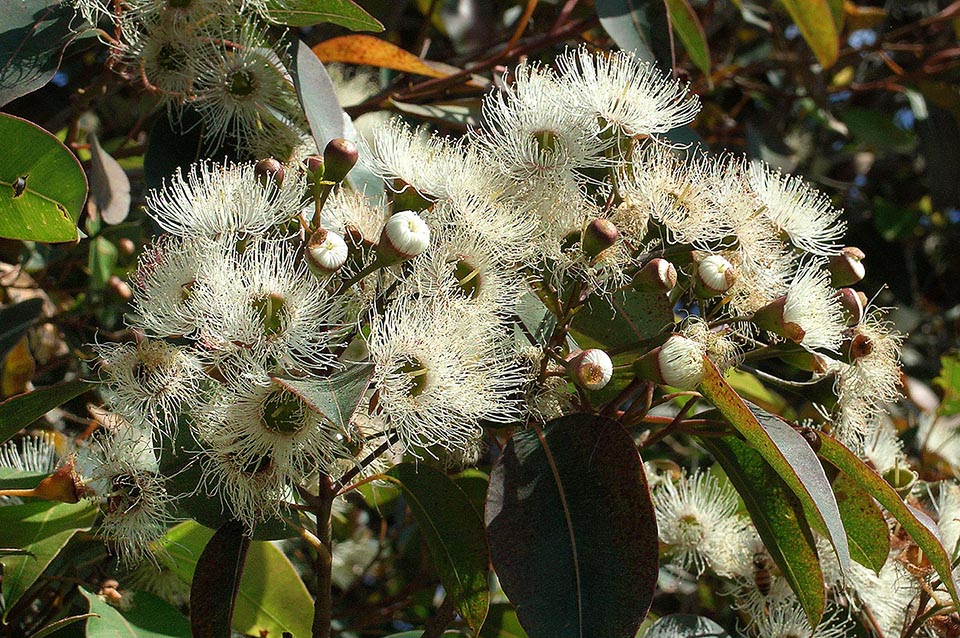
Like for many flowers finally white has been isolated. But besides being surely a decorative plant, Metrosideros excelsa shows also medicinal virtues © Peter Hunziker
The plant will grow up well with a good soil, mixed with abundant expanded clay.
The soil must be maintained at the right humidity without any water stagnation.
The fertilization with liquid fertilizer having microelements can be done every two weeks. in winter the long shoots can be cut.
In the colder climates they are to be sheltered from the wind and put outside only during the summer months.
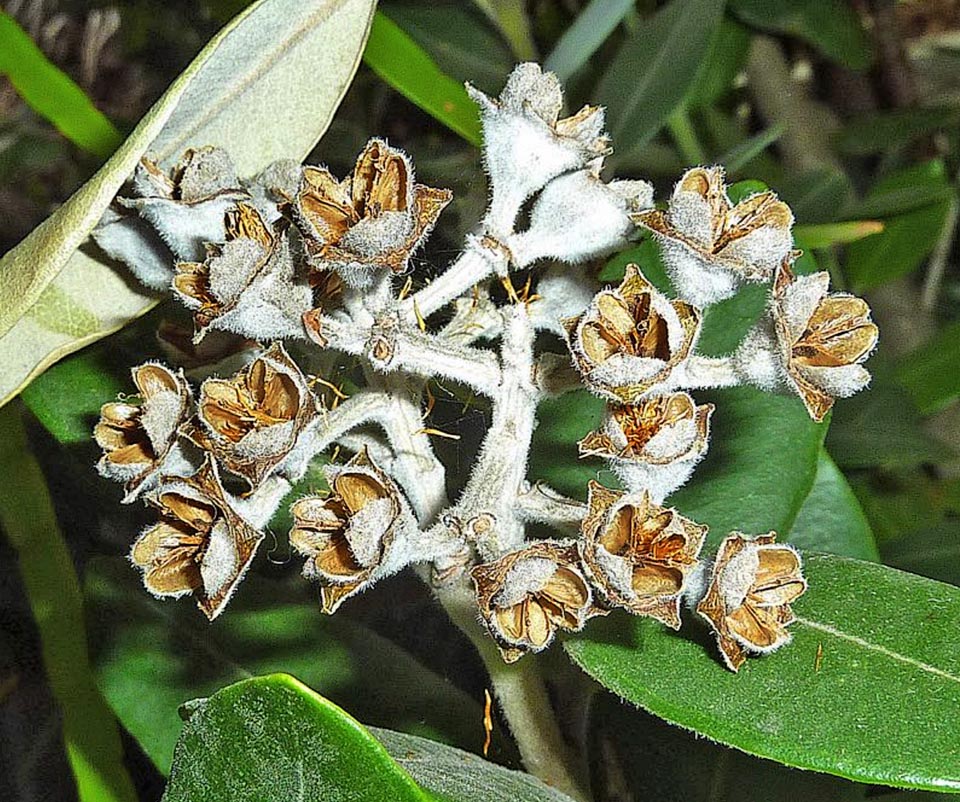
Fruits release seeds without nutrient reserves with thin covering that renders them vulnerable to drying. They then must find immediately the humidity needed to germinate © Hein van Winkel
The induction to flowering occurs in the coldest months, as a response to the reduction in the day length, however the too low temperatures has an inhibitory effect on the following opening of the flowers. In fact, to get a luxuriant flowering, the plants are to be placed in bright and cool environments at a temperatura between 5 and 12 °C. After that it is suggested to move them in a warm and exposed to the sun place.
Synonyms: Metrosideros florida var. aurata J.R.Duncan & V.C.Davies; Metrosideros tomentosa A.Rich.; Nania tomentosa (A.Rich.) Kuntze.
→ To appreciate the biodiversity within MYRTACEAE family please click here.
